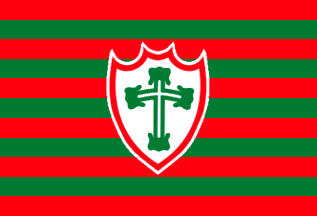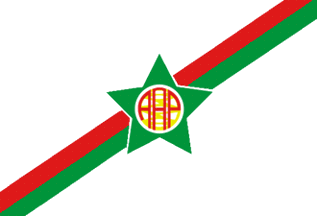![[SC Corínthians Paulista]](../images/b/br@corin.gif) image by Auriel de Almeida
image by Auriel de Almeida
Last modified: 2020-06-20 by ian macdonald
Keywords: aviz | portuguesa | sao caetano | corinthians | palmeiras | santos | são paulo |
brazil | football | soccer |
Links: FOTW homepage |
search |
disclaimer and copyright |
write us |
mirrors
The white flag provided by Auriel is vouched for at an unofficial fan
website : "The official flag of the timão was always the same: totally white with the club badge in the
center."
Joseph McMillan, 11 May 2002
At
http://www.flickr.com/photos/51033934@N07/4691403376/in/photostream/ we can
see a cartoon by Brazilian humourist Edson Rontani, featuring the flag of famous
Sport Club Corínthians Paulista. Stylized/sketched as it is, it is however
clearly the official flag, not the licensed fans’ flag or any other variant.
António Martins-Tuválkin, 22 February 2012
The licensed black supporters' flag is from soccersports.com.br (link no
longer available).
Joseph
McMillan, 11 May 2002
I recently saw on "Reporters" on BBC News 24 TV a report from São Paulo which
included a shot of what were presumably street vendors moving down a line of
stationary traffic hawking their wares. They were carrying flags which clearly
represent this football club - the badge is clear - but they are a
black-white-black vertical tricolor. Although they were not visible, the
tricolor looks as though it has room for the four stars which appear on the
black version above.
André Coutanche, 23 January 2006
![[Fans Flag of SC Corínthians ]](../images/b/br@ecas.gif) image by Ivan Sache, 2 May
2020
image by Ivan Sache, 2 May
2020
Esporte Clube Água Santa was established in 1981 in Diadema (São Paulo) The
club adopted the professional status in 2012; after three consecutive rises,
something never achieved before in São Paulo league, the club advanced in 2016
to the top level of the league (Paulistão).
https://www.ecaguasanta.com/
Club
website
The flag of EC Água Santa is white with two blue horizontal lines in
the center, superimposed by the club's emblem.
Photo:
https://twitter.com/ecaguasanta/status/1187051261901844488
Ivan
Sache, 2 May 2020
![[Fans Flag of SC Corínthians ]](../images/b/br@ipecl.gif) image by Ivan Sache, 18 May
2020
image by Ivan Sache, 18 May
2020
Ipê Clube was established in 29 January 1946 in Paulo, by a group of pelota
players of E.C. Banespa who were upset by social discrimination. The club was
named for ipê trees growing near its social seat, located near Ibirapuera Park.
http://ipeclube.com.br/
Club website
The flag of Ipê Clube is horizontally divided in ten horizontal stripes, in
turn yellow and purple, with the club's emblem placed in the center.
The
yellow and purple colors are those of ipê flowers (yellow for the golden trumpet
tree, Handroanthus albus (Cham.) Mattos; purple for the pink trumpet
tree, Handroanthus impetiginosus (Mart. ex DC.) Mattos), while the ten
stripes symbolize the ten founders of the club, Cymbelino de Freitas, Dario
Machado de Oliveira, Horácio Martins, João Vieira Machado, João Dias da Silveira
(President), José Dias da Silveira, José Antonio Sampaio, Octavio Mello, Roger
Rosenwald and Walter Leser.
http://ipeclube.com.br/o-clube/hino-bandeira-e-logo
Club website
Photos
https://www.tenispaulista.com.br/circuito-damas-2019-etapa-ipe-clube/
Ivan Sache,
18 May
2020
Palmeiras means "palm trees."
Auriel de Almeida, 13 March
2002
This flag, green with a white diagonal from lower hoist to upper fly, is
shown on the official website,
www.palmeiras.com.br/, as is the vertical green-white-green triband shown
below (click on Bandeira.
Joseph McMillan, 5 May 2002
Various unofficial sites insist on this flag with the diagonal stripe as the
official flag.
Joseph McMillan, 11 May 2002
This flag, green with a white Canadian pale and the logo on the center, is
also shown at the club website and
was provided by Auriel de Almeida of High Quality
Football Logos as the official flag of Palmeiras.
Joseph McMillan,
5 May 2002
This flag is shown at soccersports.com.br, an
online football supplies company as the official flag of Palmeiras, the logo
on a plain green background.
Joseph McMillan, 5 May 2002
 image by Luiz Paulo Neves Nunes,
21 April 2020
image by Luiz Paulo Neves Nunes,
21 April 2020
Striped horizontally red and green with the club badge, a white shield with
the Cross of the Order of Avis, on the center. From a photograph at
gazetaesportiva.com.br (article no longer on-line).
Joseph McMillan,
10 May 2002
AA Portuguesa or Portuguesa Carioca, Rio de Janeiro
 image by Luiz Paulo Neves Nunes,
21 April 2020
image by Luiz Paulo Neves Nunes,
21 April 2020
Portuguesa from Rio de Janeiro was established in 1924.
Luiz Paulo Neves Nunes,
21 April 2020
![[Flag of A.A. Portuguesa Santista]](../images/b/br@aapor.gif) image by
Luiz Paulo Neves Nunes, 21 April 2020
image by
Luiz Paulo Neves Nunes, 21 April 2020
There is another club from São Paulo, called "Associação Atlética Portuguesa."
José C. Alegría Díaz, 14 May 2002
This club is from São Paulo state, but is actually based in Santos rather
than São Paulo city. It is known as Portuguesa Santista to distinguish it
from the other Portuguesa. Portuguesa plays in the national second
division, while Portuguesa Santista is only in the state competition.
Joseph McMillan,/i> 14 May 2002
Santos is a city in São Paulo state.BR>Auriel de Almeida, 13 March 2002
This flag of São Caetano (which I believe just won this year's championship) is blue with the club badge outlined in white. Possibly unofficial; the source is a photo of the crowd at a game, at an unofficial web site.
Joseph McMillan, 11 May 2002According to one
unofficial website, the gold stars on the São Paulo FC flag have nothing to
do with football. They commemorate the world records set by Adhemar Ferreira da
Silva in the triple jump in the 1952 Olympics and the 1955 Pan American games.
The red stars are for the 1992 and 1993 world club football championships won by
São Paulo.
Joseph McMillan, 9 June 2002
Many Brazilian football clubs are named some variant of "clube de regatas," or regatta club. This is because the clubs began as rowing clubs and only later took up football. That is also why the flags of Flamengo and Corinthians have crossed oars as part of their badges.